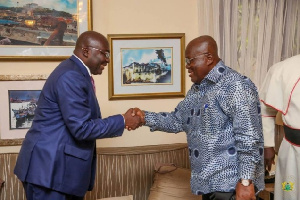Opinions of Tuesday, 17 November 2015
Columnist: thefinderonline.com
No cash for fuel, cause of dumsor
With a month to go to the end of the power crisis, as Ghanaians were promised, President John Mahama appears to have shifted the goalpost, saying the crisis (dumsor) would end before the 2016 general elections.
The President gave the extended time when he was speaking in Tamale on Saturday, indicating that it could not be a campaign message for the opposition New Patriotic Party (NPP).
"Dumsor will end before 2016 elections," President Mahama told the gathering.
The statement by the President was given further credence yesterday when the Power Minister said the current load shedding exercise may see marginal improvement by December 2015.
Dr Kwabena Donkor said this when he visited the Onyadze Power Generating Plant in the Gomoa East District in the Central Region.
It will be recalled that the Power Minister promised in February this year to resign from his post if the current power crisis persists after December 2015.
The statement from the President and Power Minister comes as no surprise. This is because the dumsor we are experiencing is more of no money to buy fuel to power thermal power plants in the Tema enclave.
With a deficit of 600 megawatts facing the country, four power plants with combined capacity of 340 megawatts are lying idle in the Tema Power Enclave because of lack of gas from Nigeria and the Volta River Authority’s inability to buy Light Crude Oil (LCO).
The plants are Tema Thermal Power Plant (TT1) with a capacity of 110 megawatts, the 50-megawatt Tema Thermal Power Plant (TT2), 100-megawatt Cenit Power Plant, and Mines Reserve Plant with the capacity to generate 80 megawatts.
Apart from the 50-megawatt Tema Thermal Power Plant (TT2), which uses only gas, all the others are dual fuel that uses either gas or LCO.
Currently, Nigeria’s N-Gas supplies an average of 35 million standard cubic feet of gas a day, and it is being used by Sunon Asogli Power Plant to generate about 300 megawatts from its combine cycle.
If N-Gas supplies the 120 million standard cubic feet of gas a day, as contained in the contract, it would be enough to power all the plants in the Tema Power Enclave.
Ever since Ghana reached an agreement to pay N-Gas the balance of $171.5 million between November 2015 and February next year, gas supply from N-Gas averages 35 million standard cubic feet a day instead of 120 million standard cubic feet of gas a day.
As of July this year, VRA owed banks to the tune of over $1.3 billion, and it will be very difficult for VRA to secure a loan from any bank in Ghana to pay its debt to N-Gas.
This means the Government of Ghana, which is the 100% owner of VRA, will have to look for money to bailout VRA to ensure that N-Gas does not cut supply to Ghana.











